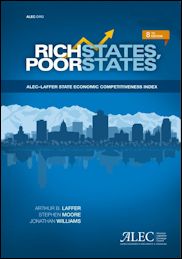 Virginia ranks No. 12 in the American Legislative Exchange Council’s just-issued eighth annual “Rich State Poor State” ranking of the economic outlook for the 50 states based on 15 state policy variables. Generally speaking, states the report authored by supply-side economists Arthur D. Laffer, Stephen Moore and Jonathan Williams, U.S. states that spend less (especially on income-transfer programs) and tax less experience higher economic growth rates than states that tax and spend more.
Virginia ranks No. 12 in the American Legislative Exchange Council’s just-issued eighth annual “Rich State Poor State” ranking of the economic outlook for the 50 states based on 15 state policy variables. Generally speaking, states the report authored by supply-side economists Arthur D. Laffer, Stephen Moore and Jonathan Williams, U.S. states that spend less (especially on income-transfer programs) and tax less experience higher economic growth rates than states that tax and spend more.
There is no question in my mind that, all other things being equal, higher taxes discourage business investment, job growth and wealth creation. And the evidence seems incontrovertible that over the long run — ironing out short- and medium-term fluctuations — a lower-tax environment is conducive to economic growth.
However, all other things are never equal. Some public investments, especially in education and infrastructure, have a higher social return on investment than others — and, arguably, a higher return than private investment. Likewise, public investment that is efficiently administered yields greater benefits than public investment guided by politics and cronyism.
The ALEC-Laffer economic competitiveness index was a useful ranking when it first came out. It’s important to know how states compare in their tax burden and other measures of economic freedom, such as debt service, judicial impartiality, number of public employees, right-to-work status and minimum wage. But the discussion can’t stop there. Unfortunately, “Rich States, Poor States” hasn’t substantively advanced the discussion since it was first implemented.
- Yes, job growth and GDP growth are important measures, but they aren’t the only important measures. How about per capita income growth? How about the distribution of income growth — are the rich getting rich while everyone else stagnates? This study should incorporate a wider range of metrics.
- Which taxes have the most adverse economic consequences? Do certain taxes distort the economy or alter incentives in ways that are more destructive than other taxes?
- How have the outlook predictions held up? It would be useful to go back to the very first “Rich States, Poor States” ranking and compare outlook to actual performance. What is the correlation between measures of economic freedom and different metrics of growth? What percentage of the variation between states can be explained by Laffer’s measures? 10 percent? 20 percent? More? Less? What other variables matter?
- Rather than look at total government spending, the study should look at different segments of spending. Is there a correlation between how much a state spends on education and economic outcomes? How about what a state spends on infrastructure? And how about amenities that supposedly matter to members of the creative class?
It seems like Laffer, Moore and Williams are on auto-pilot. The discussion about economic development has left “Rich States, Poor States” in the dust. Simply reiterating old nostrums, no matter how true in a general sense, doesn’t advance the public policy debate. Whacking tax rates is no recipe for prosperity, as Kansas Governor Sam Brownback has learned from his tax-cutting adventure. If this report doesn’t start plowing new ground, intellectually speaking, it will soon outlive its usefulness.
— JAB


